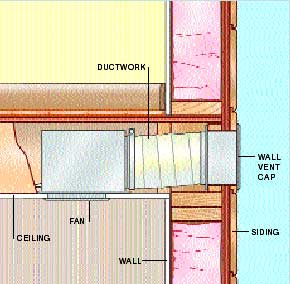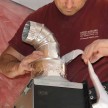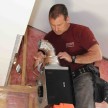Bathroom Duct Venting
Bathroom shower Vent
This article will address bathroom duct venting options. The two most common ways to route duct work to vent bathroom moist air outside are:
1. through the ceiling and out through an exterior wall.
2. through the ceiling and out through the roof.
Of the two bathroom duct venting options. a vent through a wall, done properly, is less likely to leak.
In my travels I have seen many improperly vented bathroom fans and dryer ducts and hoods.Improper venting of a fan can cause moisture problems which can result in condensation forming within the vent, duct or house.
Condensation can run back down an improperly pitched duct, leaking around the fan, creating stains, causing structural rot problems or drip back out of the fan and into the room.

Photo: Improperly vented fan into attic. Notice mold on roof sheathing.
Do NOT Vent Into The Attic
Many builders and contractors take shortcuts and vent fans directly into the attic. This only fills the attic with mold causing moist air. The result is an increase in the possibility of attic mold and wood rot. In winter, frost forms in the attic surfaces and as the frost melts, water can damage the ceilings below.
If the attic framing allows, I feel that it is always better to install duct-work and vent the fan through the nearest soffit or gable side wall. This allows you to make the vent installation under the overhang of the roof, preventing the need for a roof vent.
A fan can be ducted to the soffit hood vent using flexible metal or solid duct material. I prefer to use the flexible metal or solid aluminum piping. [seams taped and installed facing up]
Installing a vent duct horizontally across the attic, and slightly pitched toward the outside hood reduces the possibility of condensation trickling back down around the fan.
Insulating the duct with insulation wrap also can reduce some of the formation of condensation within the duct. Click here for more detail on bathroom duct venting options and vent duct work.
~ concord carpenter











